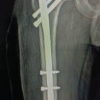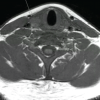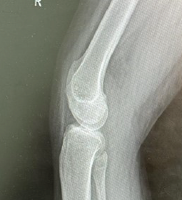A polytrauma principles – (Early total care) helps in functional and clinical recovery.
Dr. Dheeraj Attarde, Department of Orthopaedic, Sancheti Institute of Orthopaedics and Rehabilitation, Pune, Maharashtra, India. E-mail: dheerajattarde@yahoo.co.in
Introduction: Bilateral bifocal femur fractures occur as a result of high-velocity trauma mainly road traffic accidents with dashboard injuries or fall from height. These fractures can result in high morbidity or mortality as they are usually presented with hypovolemic shock or fatal fat embolism syndrome.
Case Report: We present a 47-year-old male with a history of fall from 35 feet. He sustained a symmetrical intertrochanteric femur fracture with a diaphyseal femur fracture with a bilateral patella fracture. There was no evidence of any head injury or spinal fracture. The patient reached the emergency room in hypotension and was maintaining saturation on room air. The patient was admitted to the intensive care unit; hypotension was corrected overnight and was operated on after 24 h with bilateral intramedullary long proximal femoral nail and tension band wiring for the bilateral patella fractures. At 1-year follow-up, he was able to do his daily activities with minimal limitation.
Conclusion: Bilateral bifocal femur fractures result from a high-velocity trauma. In such injuries, careful evaluation of all the systems should be performed to find out concomitant injuries. Single-staged surgical intervention decreases the morbidities of the subsequent surgeries, helps in a rehabilitation hospital stay as well as financially suitable for the patient.
Keywords: Bilateral, bifocal femur, intertrochanteric, diaphyseal.
Intertrochanteric femur fractures with diaphyseal femur shaft fractures are commonly seen in orthopedic emergency rooms, but symmetrical bilateral fractures are pretty rare. Bilateral fractures commonly result from a high-energy trauma or fall from height [1]. The management of such injuries is quite crucial and our aim in this article is to show that simultaneous fixation of all the fractures is beneficial and gives good results. Patient’s age, other associated injuries, and comorbidities should be examined closely [2]. According to the best of our knowledge, there is no such case reported in the literature till now
A 47-year-old male came to the emergency department with a history of falls from 35 feet. The examination was done as per advanced trauma life support protocol [3,4] and it was found that his BP was 100/60, pulse 90/min and he was maintaining 98% saturation on room air. After clinical examination, radiographs were done and it was found that the patient has symmetrical bilateral intertrochanteric femur fractures with bilateral diaphyseal fractures and bilateral patella fractures (Fig. 1). All the routine blood investigations including serum lactate and arterial blood gas were done, bilateral upper tibia skeletal traction was applied, and the patient was admitted to the intensive care unit (ICU) for observation as there is always a risk of hypovolemic shock or fat embolism syndrome in such patients. The patient was optimized and reviewed by the medical team and anesthetist team, serum lactate was repeated and after 24 h in a single setting, and bilateral long proximal femoral nailing was done with bilateral tension band wiring for the patella fracture. As it was a complex fracture, and it was difficult to position for spinal anesthesia, surgery was carried out under general anesthesia. The right side was addressed first with a lateral position and then after changing to the right lateral position left side was addressed. The patella was fixed in a lateral position after stabilizing the femur. The IT fracture was reduced with hook and the diaphysial fracture was reduced with mini-open technique with clamps. After confirming reduction, fixation was carried out (Fig. 2 and 3). The patient was again kept in the ICU for observation and subsequently shifted to the ward after 48 h of surgery. In bed, physiotherapy was immediately started after surgery and the patient was mobilized on a wheelchair after 48 h. The radiological union was found at 4 months in the intertrochanteric fractures and at 6 months at diaphyseal and patella fractures (Fig. 4 and 5). The patient was full weight-bearing without support at 3 months and doing his all routine activities with minimal limitations at 8 months postoperatively. The patient developed a foot drop on the right side immediately post-surgery which recovered on its own after 6 weeks.
All the routine blood investigations including serum lactate and arterial blood gas were done, bilateral upper tibia skeletal traction was applied, and the patient was admitted to the intensive care unit (ICU) for observation as there is always a risk of hypovolemic shock or fat embolism syndrome in such patients. The patient was optimized and reviewed by the medical team and anesthetist team, serum lactate was repeated and after 24 h in a single setting, and bilateral long proximal femoral nailing was done with bilateral tension band wiring for the patella fracture. As it was a complex fracture, and it was difficult to position for spinal anesthesia, surgery was carried out under general anesthesia. The right side was addressed first with a lateral position and then after changing to the right lateral position left side was addressed. The patella was fixed in a lateral position after stabilizing the femur. The IT fracture was reduced with hook and the diaphysial fracture was reduced with mini-open technique with clamps. After confirming reduction, fixation was carried out (Fig. 2 and 3). The patient was again kept in the ICU for observation and subsequently shifted to the ward after 48 h of surgery. In bed, physiotherapy was immediately started after surgery and the patient was mobilized on a wheelchair after 48 h. The radiological union was found at 4 months in the intertrochanteric fractures and at 6 months at diaphyseal and patella fractures (Fig. 4 and 5). The patient was full weight-bearing without support at 3 months and doing his all routine activities with minimal limitations at 8 months postoperatively. The patient developed a foot drop on the right side immediately post-surgery which recovered on its own after 6 weeks.
Unilateral femoral fractures are seen routinely in daily practice but symmetrical bilateral fractures are rare. Bilateral fractures are usually caused by high-velocity trauma; however, long-term bisphosphonate therapy can also lead to bilateral fractures [5]. Similarly, bilateral femur fractures have also been reported after long-term steroid-induced osteoporosis. Shaheen and Sabet [6] reported bilateral femoral neck fractures following electrical shock whether accidental or controlled, for example, electroconvulsive therapy. Capeci and Tejwani [7] reported bilateral femoral fractures with long-term alendronate therapy. It says while alendronate therapy is used to reduce the risk of vertebral and femoral neck fractures in postmenopausal women, recent reports have associated long-term use of alendronate therapy, which have resulted in low-energy subtrochanteric and diaphyseal femoral fractures in some patients. The timing of the surgery in such polytrauma patients is a point of concern. Our patient was operated on within 24 h of surgery and all the long bones were stabilized with single-stage internal fixation devices [4]. The early total care concept was followed here. Studies have reported lesser pulmonary complications as well as sepsis are directly related to the timing of surgery. Early total care in such long bone fractures was found to have less incidence of fat embolism and hemodynamic decompensation. The idea of surgery in such patients should be acceptable and not the anatomic reduction preferably by closed methods but one should never hesitate to open reduce the fractures when close reduction is difficult to achieve, as surgical time is also an important factor in the outcome of such patients [8-10]. In our case, we chose a recon nail which is a side-specific femoral nail which has two 6.5 mm screws which go in the head of the femur and 2 locking bolts distally. We did either femur nailing in a lateral position with ipsilateral patella fixation before flipping the patient to the other side. One of the diaphyseal femur fractures was open reduced by the mini-open technique [11]. We followed up with our patient every 6 weeks for the initial 3 months and every 3 months later on. The patient had an excellent radiological union at the end of 6 months in all his fractures and he was able to perform all his activities with minimal limitation.
Bilateral femur fractures are a rare entity. Adequate fluid resuscitation, early one-stage internal fixation of both fractures, following polytrauma principles and early mobilization of the patient are the major determinants of successful outcomes. Single-staged surgeries decrease the morbidities, help in the rehabilitation, and reduce the hospital stay in such critical patients.
Polytrauma management poses as challenge and no conclusive evidence exist. With newer advances of implants and early total care principles, well-directed surgical fixation can achieve good functional and radiological outcome without increasing morbidity.
References
- 1.Grisoni N, Foulk D, Sprott D, Laughlin RT. Simultaneous bilateral hip fractures in a level I trauma center. J Trauma 2008;65:132-5. [Google Scholar]
- 2.Krueger A, Frink M, Kiessling A, Ruchholtz S, Kühne CA. Emergency room management: In the era of the white paper, S3 guidelines, advanced trauma life support® and trauma network DGU® of the German society of trauma surgery. Chirurg 2013;84:437-50. [Google Scholar]
- 3.Bali K, Krishnan V, Sen R. Bilateral pertrochanteric fractures with bilateral patellar fractures with missed medial process fracture of talus in a young adult: A case report and review of literature. Musculoskeletal Surg 2011;95:259-63. [Google Scholar]
- 4.Rixen D, Steinhausen E, Sauerland S, Lefering R, Maegele MG, Bouillon B, et al. Randomized, controlled, two-arm, interventional, multicenter study on risk-adapted damage control orthopedic surgery of femur shaft fractures in multiple-trauma patients. Trials 2016;17:47. [Google Scholar]
- 5.Kose N, Özçelik A, Günal I, Seber S. Spontaneous bilateral hip fractures in a patient with steroid-induced osteoporosis--a case report. Acta Orthop Scand 1998;69:195-6. [Google Scholar]
- 6.Shaheen MA, Sabet NA. Bilateral simultaneous fracture of the femoral neck following electrical shock. Injury 1984;16:13-4. [Google Scholar]
- 7.Capeci CM, Tejwani NC. Bilateral low-energy simultaneous or sequential femoral fractures in patients on long-term alendronate therapy. J Bone Joint Surg 2009;91:2556-61. [Google Scholar]
- 8.Pape HC, Giannoudis P, Krettek C. The timing of fracture treatment in polytrauma patients: Relevance of damage control orthopedic surgery. Am J Surg 2002;183:622-9. [Google Scholar]
- 9.Pape HC, Tornetta P 3rd, Tarkin I, Tzioupis C, Sabeson V, Olson SA. Timing of fracture fixation in multitrauma patients: The role of early total care and damage control surgery. J Am Acad Orthop Surg 2009;17:541-9. [Google Scholar]
- 10.Tahririan MA, Andalib A. Is there a place for open intramedullary nailing in femoral shaft fractures? Adv Biomed Res 2014;3:157. [Google Scholar]
- 11.Dendrinos G, Kousoulas D, Papagiannopoulos G. Simultaneous bilateral trochanteric and subtrochanteric fractures. J Trauma 1993;34:157-60. [Google Scholar]










